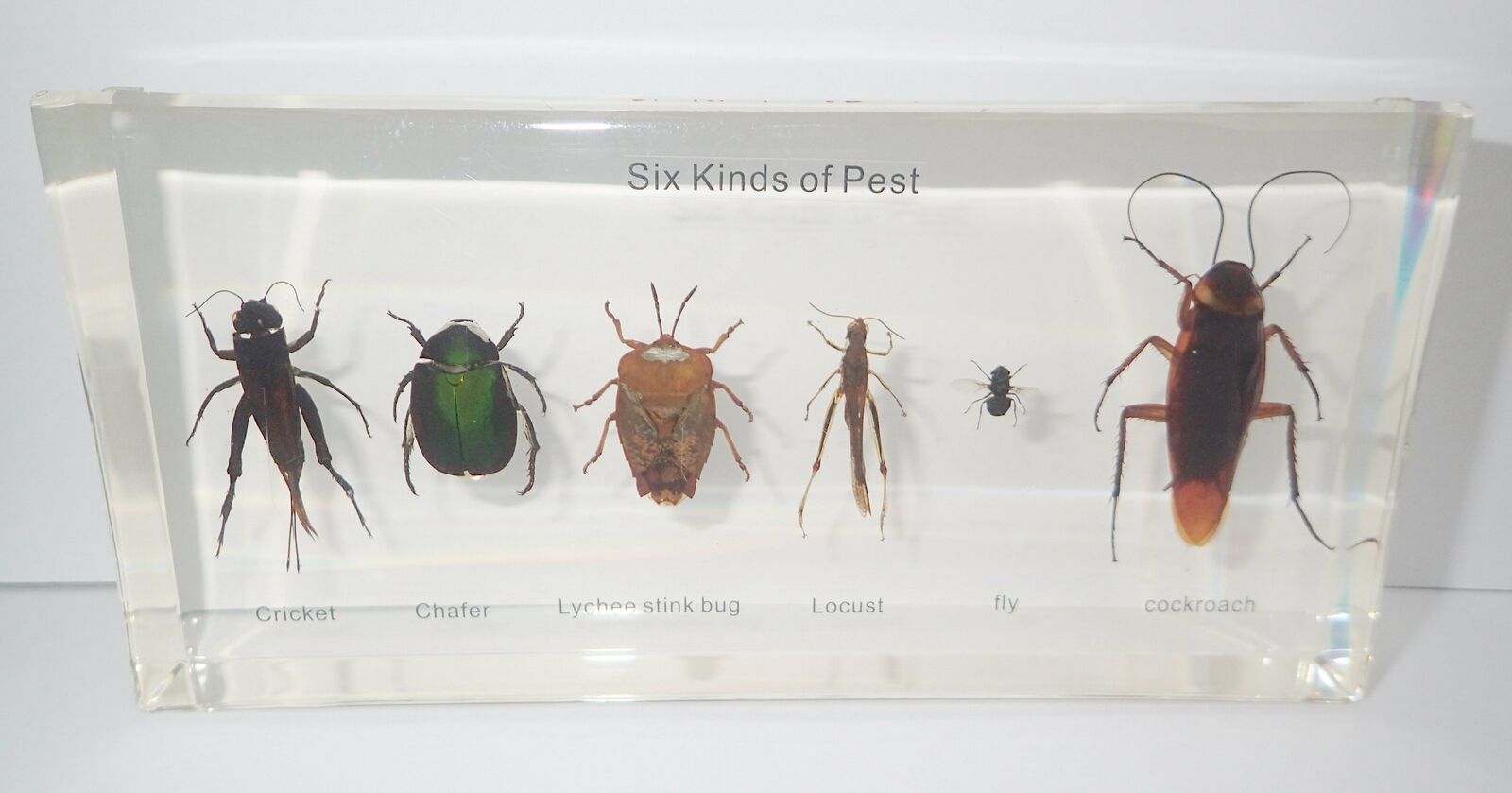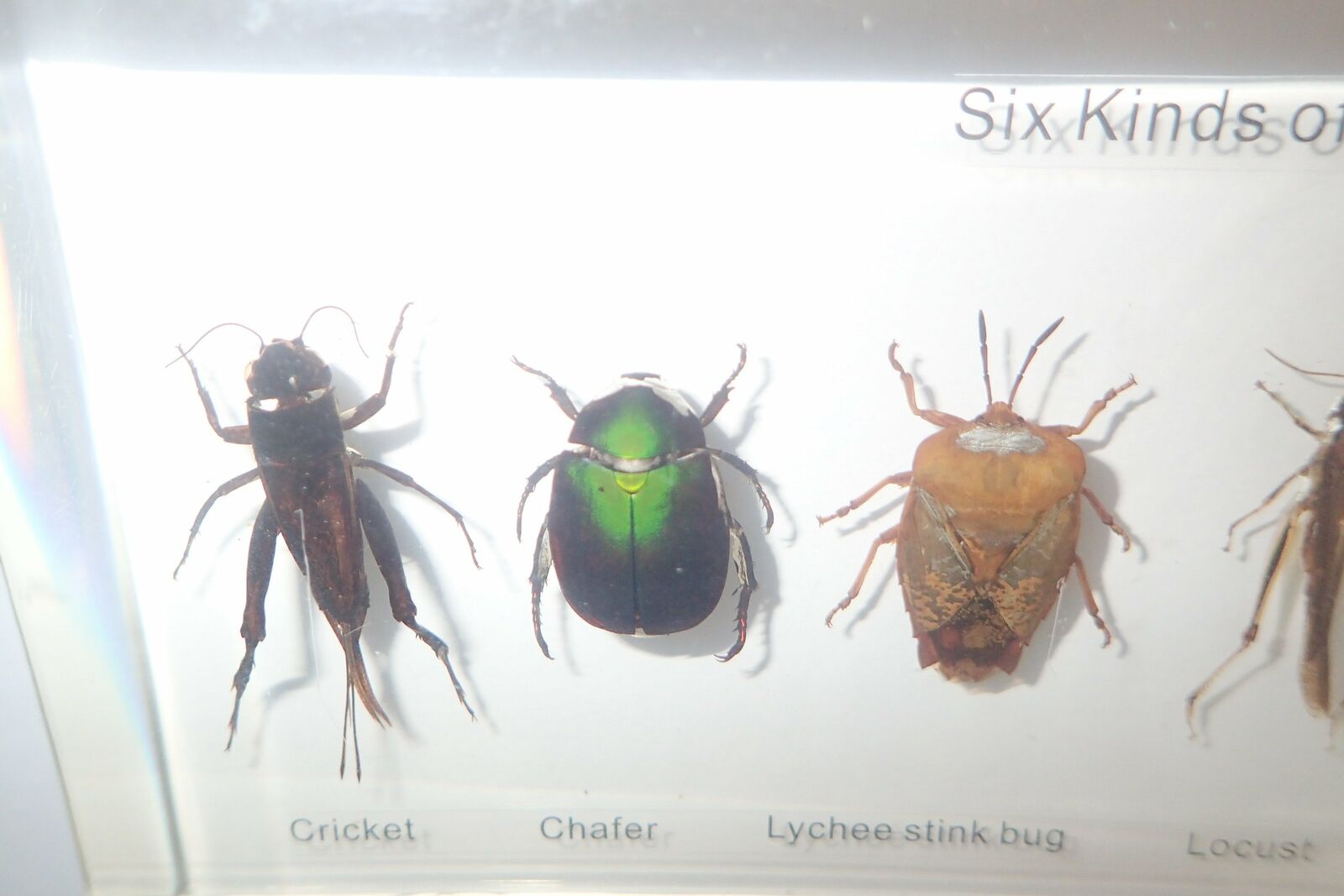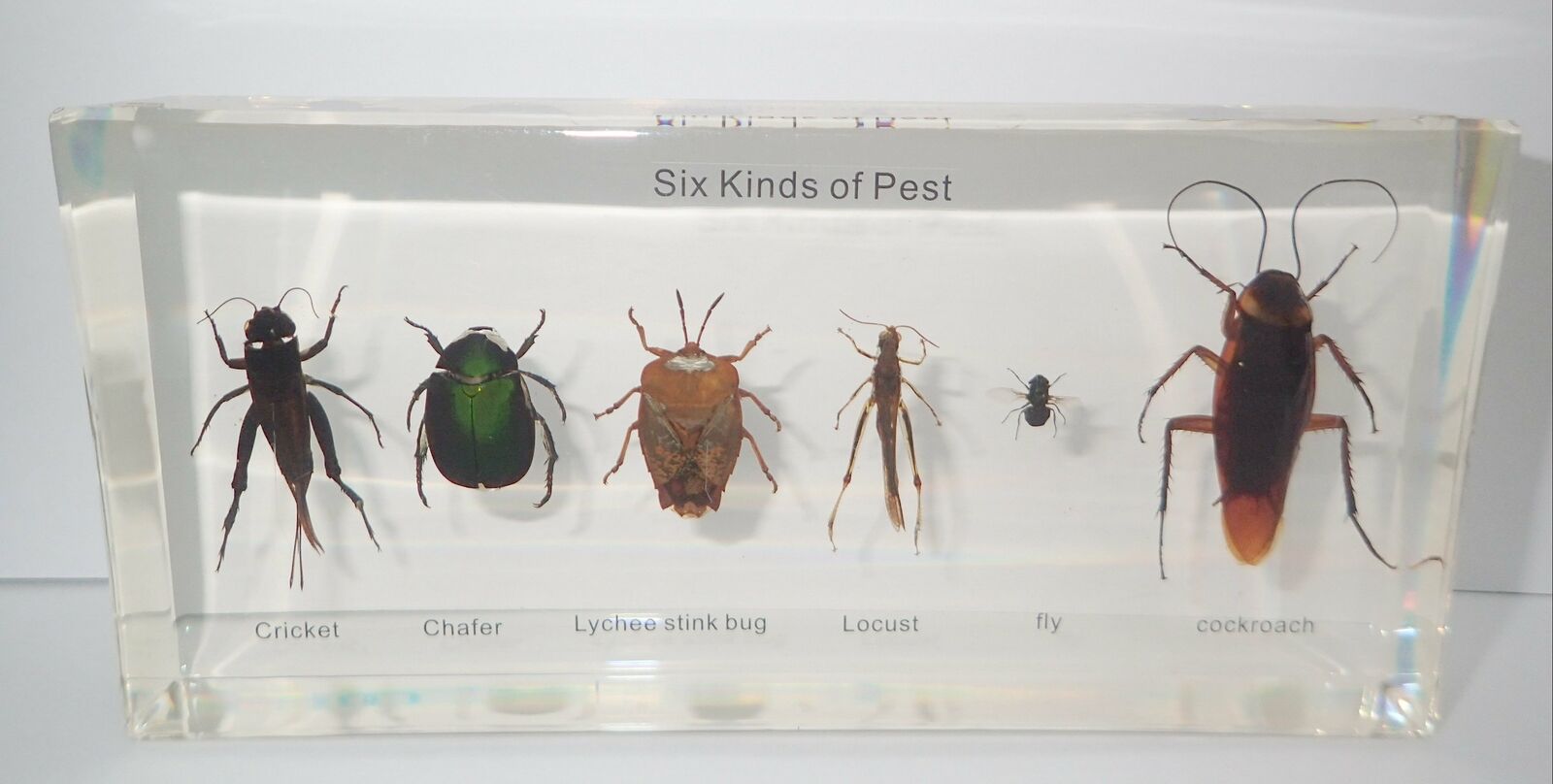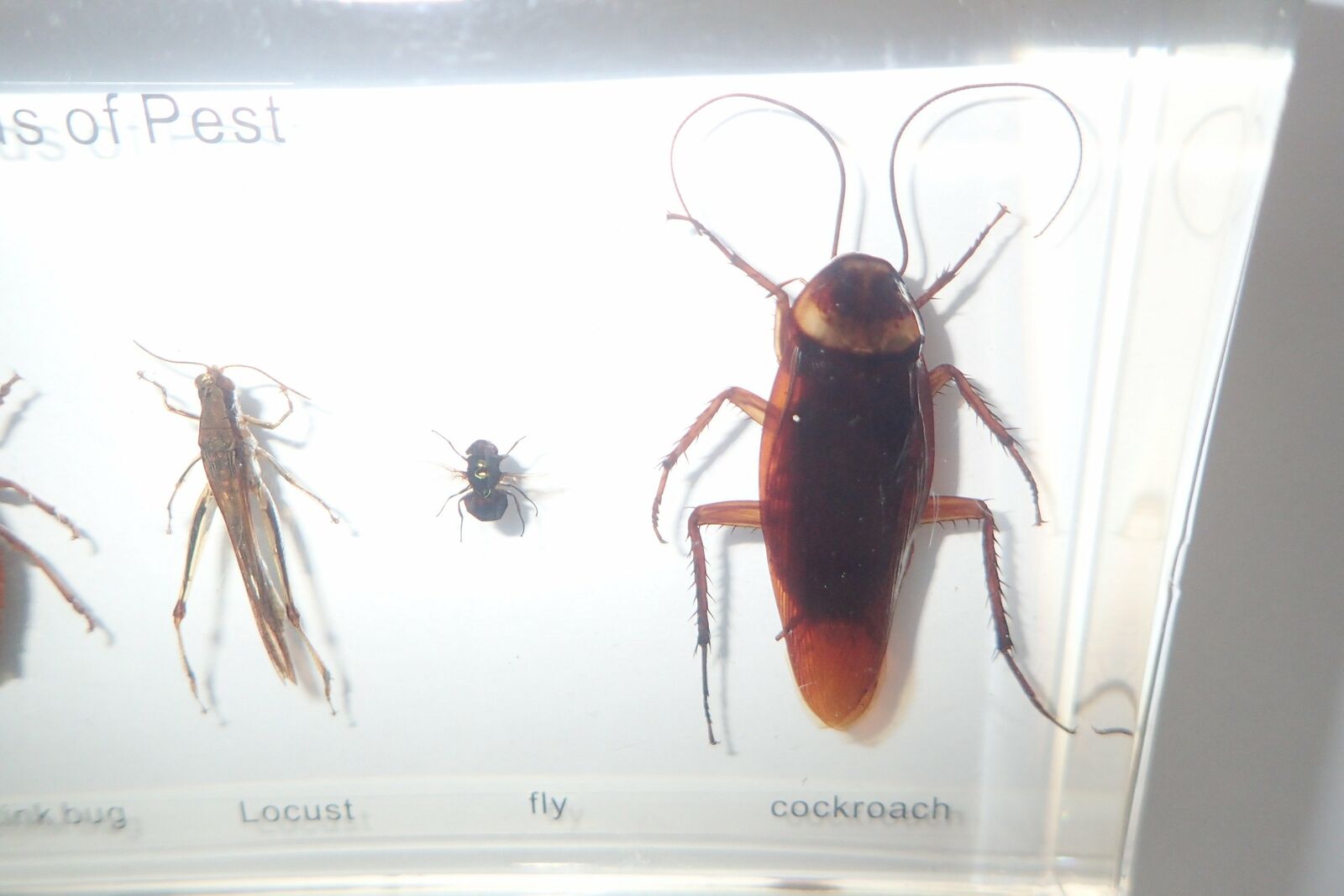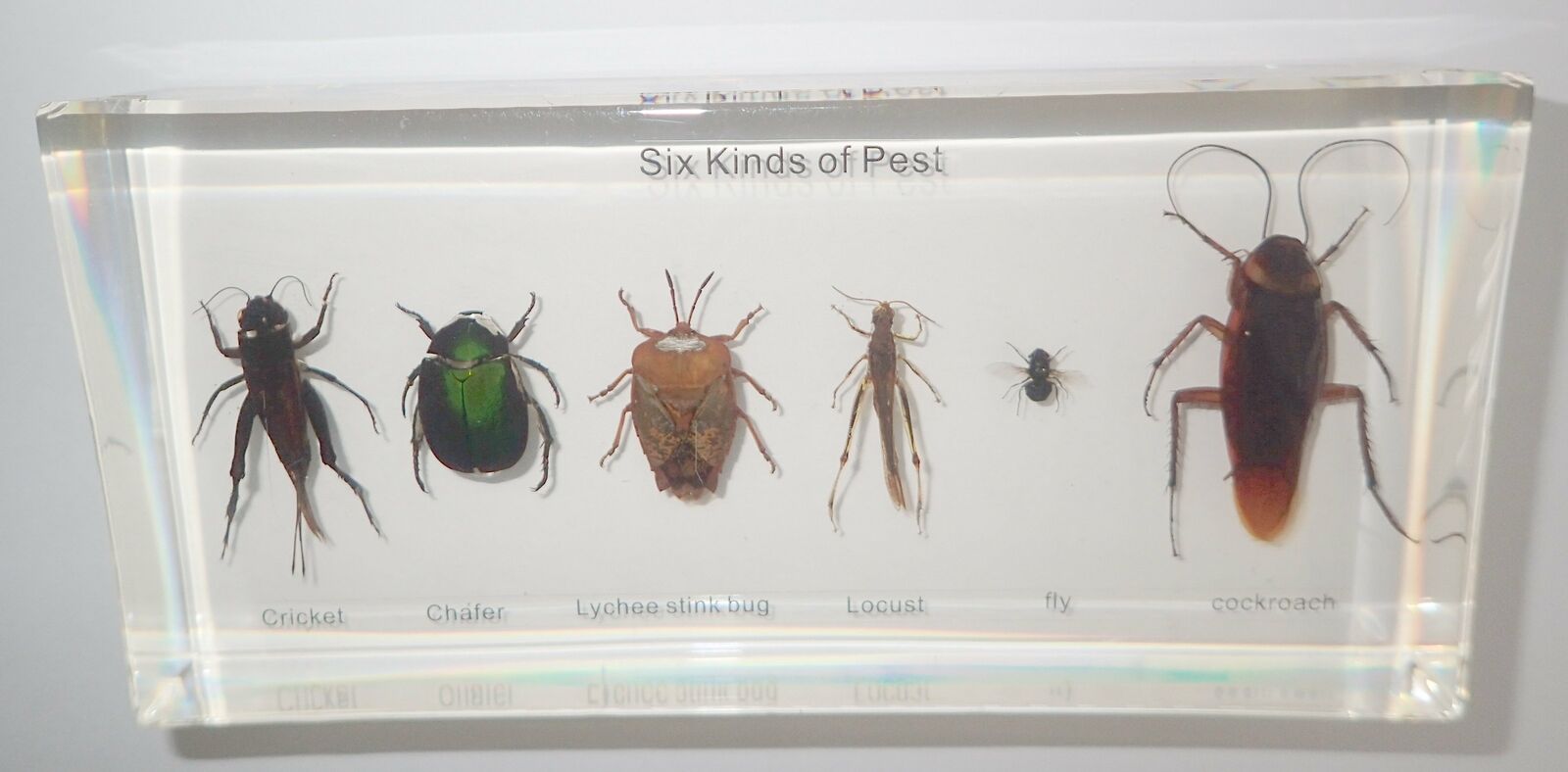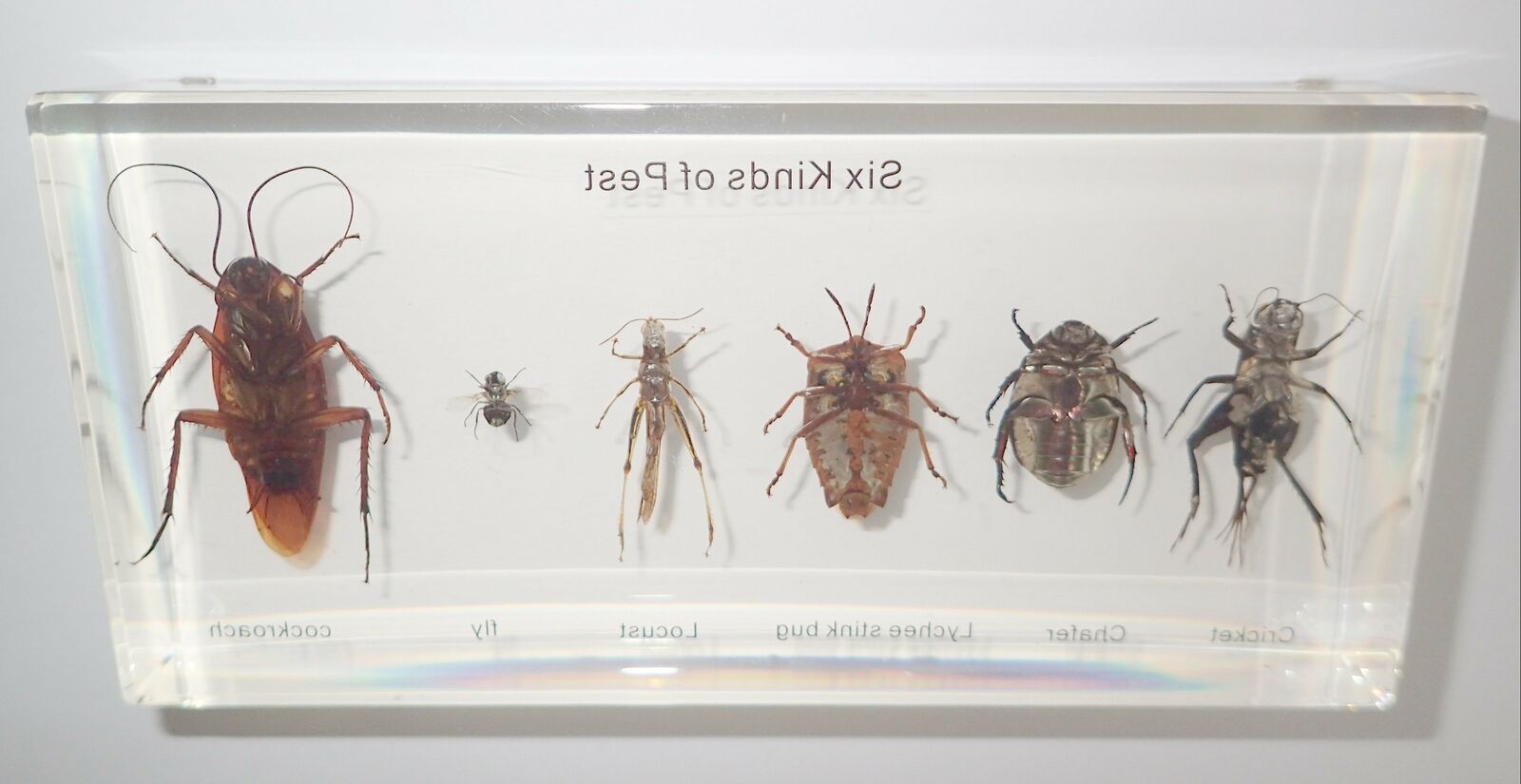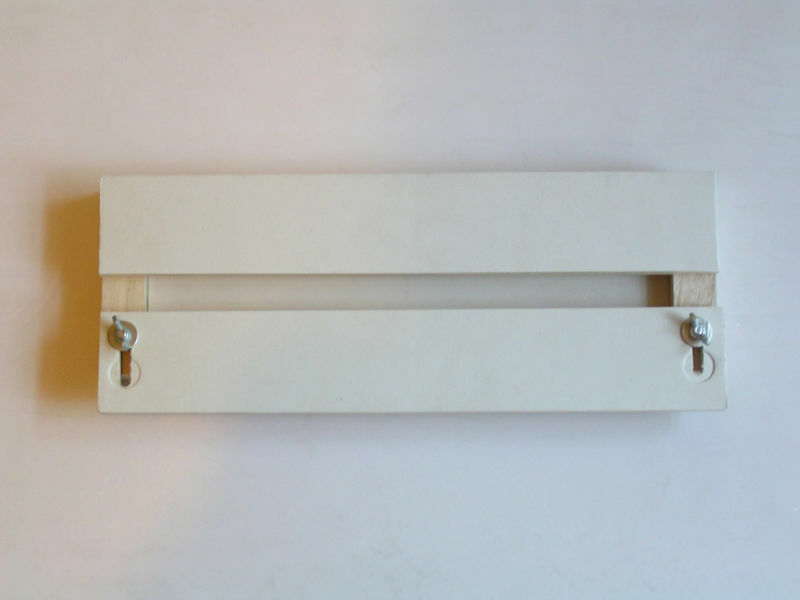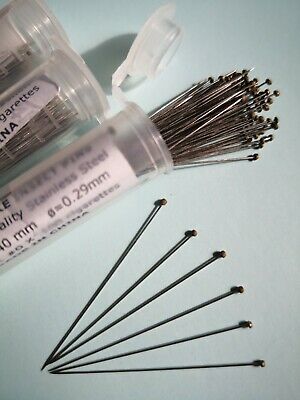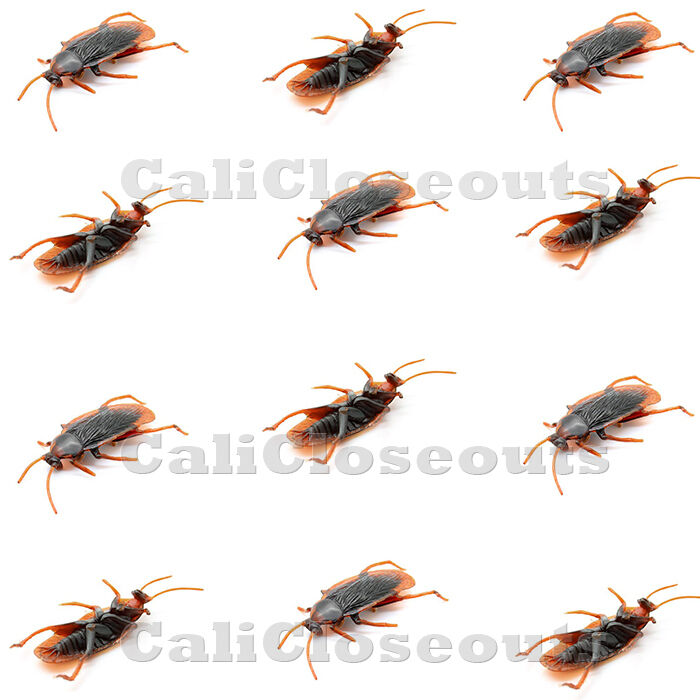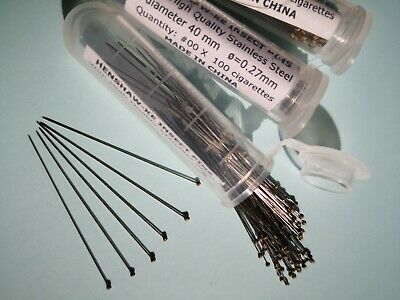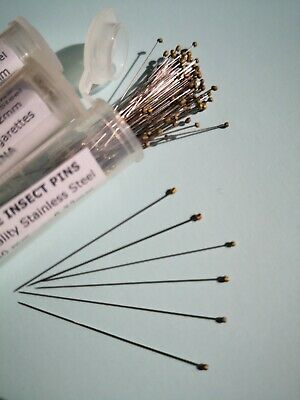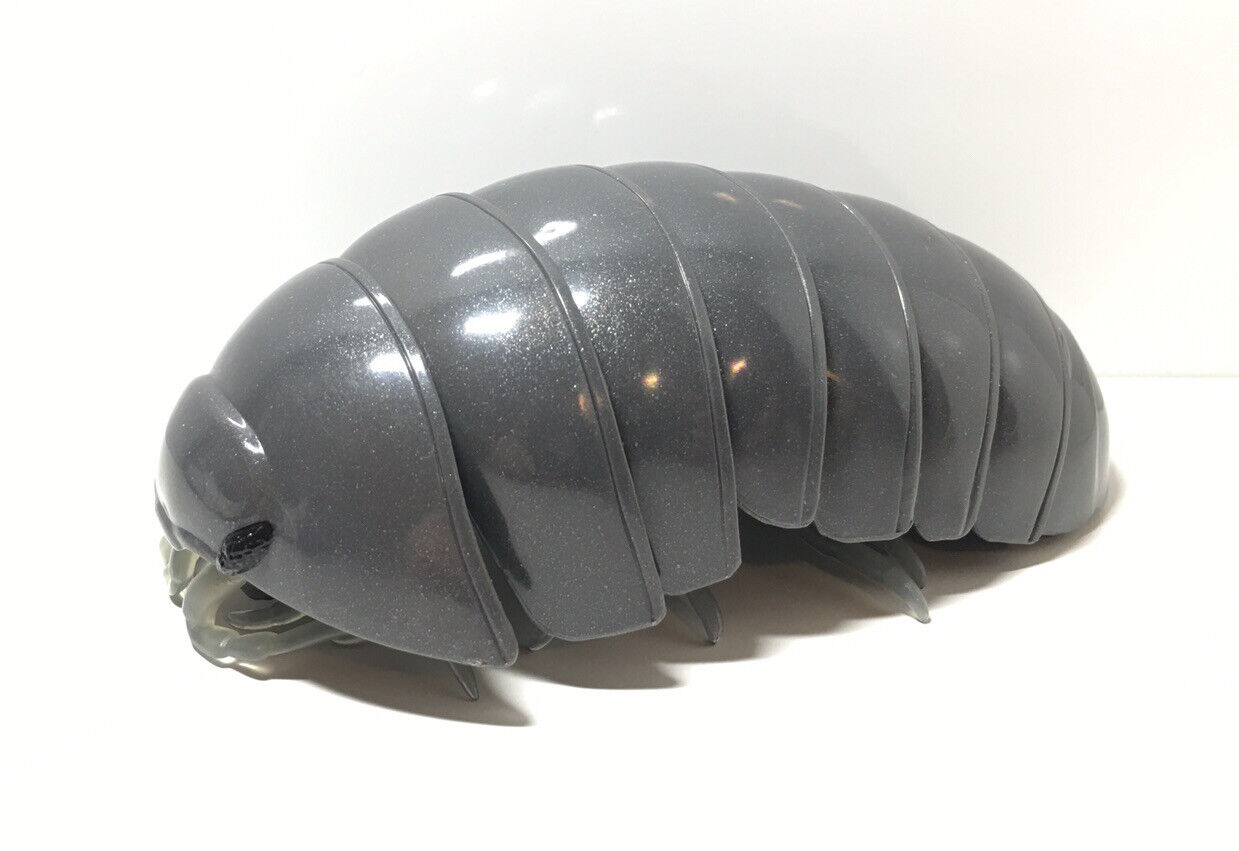-40%
Six Kinds of Pest Insect Set in Clear Block Education Real Specimen
$ 20.06
- Description
- Size Guide
Description
Six Kinds of Pest Insect Specimen SetReal Grass Cricket - Paratrigonidium bifasciatum, Green Chafer Beetle - Anomala cupripes, Golden Bug(Lychee Stink Bug – Tessaratoma papillosa), Grasshopper (Rice Locust - Oxya chinensis, Blue Bottle Fly - Calliphora vomitoria and American Cockroach (Periplaneta americana) specimens encased in clear lucite material. The specimen is crystal clear, indestructible and transparent. Safe, authentic and completely unbreakable product put real specimens right at your fingertips!
Anyone can safely explore the specimens from every angle.
It is clear enough for microscope observation.
The Nature Garden
Six Kinds of Pest Insect Set in Clear Block Education Real Specimen
Six Kinds of Pest Insect Specimen Set
Real
Grass Cricket -
Paratrigonidium bifasciatum,
Green Chafer Beetle -
Anomala cupripes
,
Golden Bug(Lychee Stink Bug
– Tessaratoma papillosa),
Grasshopper (Rice Locust -
Oxya chinensis,
Blue Bottle Fly -
Calliphora vomitoria
and
American Cockroach (
Periplaneta americana
)
specimens encased in clear lucite material. The specimen is crystal clear, indestructible and transparent. Safe, authentic and completely unbreakable product put real specimens right at your fingertips!
Anyone can safely explore the specimens from every angle.
It is clear enough for microscope observation.
Size of the lucite block is 16.5x7.8x2.5 cm(6.5x3.1x1.0 inch).
Each one comes with a cardboard box for easy storage.
Weight of the lucite block is 300 g and 500 g with packing box.
1:
Grass Cricket
2:
Green Chafer Beetle
3:
Lychee Stink Bug
4:
Grasshop
per
5:
Blue Bottle Fly
6:
American Cockroach
This is a handmade real animal specimen craft. Each one will be a bit different (specimen size, color and posture) even in the same production batch.
The pictures in the listing are just for reference as we are selling multiple pieces with same pictures.
It is an ideal learning aid for students and kids and also a very good collectible item for every body.
***
Grass Cricket -
Paratrigonidium bifasciatum
18-24 mm body length, body color Danhese, chest Cross backplane with brown stripes, vertical fin clock with stripes, brown Houjia legs of a ramp belt, the female with eggs. Living in the plains and low-elevation mountains, common in the shade of trees or bushes on the back of habitats, the general distribution of the island is a common species.
Green Chafer Beetle -
Anomala cupripes
Distribution: Southern China
Body size: 18 – 30 mm
Anomala cupripes
Hope, a common and important chafer injures many fruit trees, forest, cereal and ornamental crops. Its larvae feed on plant roots while the adults aggregate and feed on foliage. This insect occurs mainly between June and August each year.
Ecological habits:
Adults often 4 to 8 months there. 5 ~ which is a peak in July, egg powder produced in the territories, egg stage 13 ~ on the 19th after hatching of larvae to humic for food, often in the compost can be found in the larvae. Application of compost will be brought into larvae Tanaka. Larvae in the ground in winter. 3 to May the following year pupate. Adults are activities day and night, becoming light of the lamps in attracting insects can often trap to a large number of adults.
Description:
Taiwan bronze beetles: adult in the Oval, with the back of the green beautiful carved a minor point, ventral Anhuang copper quite smooth, full violet. Fin sheath edge of the back-end side of the wing-shaped extension, especially male, approximately 2.2 to 2.7 cm. U shaped larvae of these lanes are bending early white, a yellow, aging, tawny head, upper lip semicircular, a Long Hair Health Board. Article 10 of the back of the central abdominal bristles with the Second Board. Foot very sharp claws, the body length of 5.0 to 5.5 cm. Pupae were spindly, yellow light, tail section of the web female was lunate. Shengshikong opened in the central base. Male is more prominent one, in the 2.5 to 3.0 cm.
Harm
:
Shoot or adult eating leaves, which cannot shoot growth, and often two to five adults on feeding, which was a new leaf and make eating only remaining branches, and the Department of harm long strip of waste pollution.
Lychee Stink Bug
– Tessaratoma papillosa
Distribution: Southern China, SE Asia
Body length: 20-24 mm
Adult feeding of the stink bug, Tessaratoma papillosa Drury occurred on flowering, tender and tough branches of the host-plant, litchi. However, their feeding behavior in their pre-overwintering and reproductive stages was obviously different. 50%~70%and 100%of adults fed on all the three kinds of branches in their pre-overwintering and reproductive stages, respectively. Placed on these branches, the pre-feeding period of the stink bugs at pre-overwintering stage was longer than that at reproductive stage. The feeding behavior of the stink bugs on different kinds of branches differed greatly. The pre-feeding period of the stink bugs on flowering or tender branches was much shorter than that on tough one. The stink bugs preferred feeding flowering and tender branches in the choice test. The contents of water, nitrogen and soluble sugars in flowering and tender branches were higher than that in tough one and the content of soluble sugars in all three types of branches varied during the reproductive stage of the stink bug. Tender and flowering branches differed from tough one in morphology and histology.
Rice Locust -
Oxya chinensis
Found in eastern Asia, occasionally a serious pest of rice, also attacks other crops
Locust (family Tetrigidae, order Orthoptera) has a distinctive pronotum that extends back over all of the abdomen, often tapering to a point. Females lay eggs in damp soil. Can be found worldwide, mainly in warmer regions. On bare or sparsely covered ground in moist, wooded areas and the edges of bogs and lakes.
Blue Bottle Fly -
Calliphora vomitoria
Order: Diptera
Suborder: Brachycera
Infraorder: Muscomorpha
Subsection: Calyptratae
Superfamily: Oestroidea
Family: Calliphoridae
Subfamily: Calliphorinae
Tribe: Calliphorini
Genus:
Calliphora
Species:
C. vomitoria
The
blue bottle fly
or bottlebee (
Calliphora vomitoria
) is a common blow-fly found in most areas of the world and is the type species for the genus
Calliphora
.
It is 10-14 mm long, slightly larger than a housefly. The head and thorax are dull gray and the abdomen is bright metallic blue with black markings. Its body and legs are covered with black bristle-like hair. The eyes are red and the wings are clear. The legs and antennae are black.
Life cycle
A female blue bottle fly lays her eggs where she feeds, usually in decaying meat, garbage, or feces. Pale whitish larvae, commonly called maggots, soon hatch from the eggs and immediately begin feeding on the decomposing matter where they were hatched. After a few days of feeding, they are fully grown. At that time they will crawl away to a dry place where they can burrow into soil or similar matter to pupate into tough brown coccoons. After two or three weeks, the adults emerge to mate, beginning the cycle again. During cold weather, pupae and adults can hibernate until warmer temperatures revive them.
They are pollinators of some flowers with a strong odor such as skunk cabbage and goldenrod.
American Cockroach (Periplaneta americana
, family Blattidae, order Blattodea): It is often used in laboratories because it is easy to culture. Originally from Africa, it is now found worldwide. They are highly active, can run very fast, and fly in hot conditions. They usually hide during the day, coming out to feed after dark. They eat a range of organic matter and food scraps, regurgitating already digested food and leaving behind their faeces and a characteristic unpleasant smell. Males may have special glands on their back, which secrete chemicals that lure a mate into a suitable position for copulation. Females can produce up to 50 egg cases, each containing 12-14 eggs. The egg cases may be deposited on, buried in, or stuck to a variety of surfaces. ***
Item Specifics
Material :
Resin
Type :
Collector Plate
Country of Manufacture :
China
Country/Region of Manufacture :
China
UPC :
Does not apply
Modified Item :
No
Payment
By Paypal
Shipping
Free shipping cost.
We send the goods to USA, Canada, UK, Australia, New Zealand, EU countries and some other European and Asian countries by E-express, a kind of fast postal service by Hong Kong Post. It usually takes about 6 to 10 working days for delivery.
We send the goods to other countries by registered airmail and will take about 8 to 14 working days for delivery.
Returns
Returns: We accept returns with any reason in 30 days.
Contact Us
We will answer buyer messages within 24 hours during working days.
The Nature Garden
From all around the world
DESCRIPTION
PAYMENT
SHIPPING
RETURN POLICY
CONTACT US
Six Kinds of Pest Insect Set in Clear Block Education Real Specimen
Six Kinds of Pest Insect Specimen Set
Real
Grass Cricket -
Paratrigonidium bifasciatum,
Green Chafer Beetle -
Anomala cupripes
,
Golden Bug(Lychee Stink Bug
– Tessaratoma papillosa),
Grasshopper (Rice Locust -
Oxya chinensis,
Blue Bottle Fly -
Calliphora vomitoria
and
American Cockroach (
Periplaneta americana
)
specimens encased in clear lucite material. The specimen is crystal clear, indestructible and transparent. Safe, authentic and completely unbreakable product put real specimens right at your fingertips!
Anyone can safely explore the specimens from every angle.
It is clear enough for microscope observation.
Size of the lucite block is 16.5x7.8x2.5 cm(6.5x3.1x1.0 inch).
Each one comes with a cardboard box for easy storage.
Weight of the lucite block is 300 g and 500 g with packing box.
1:
Grass Cricket
2:
Green Chafer Beetle
3:
Lychee Stink Bug
4:
Grasshop
per
5:
Blue Bottle Fly
6:
American Cockroach
This is a handmade real animal specimen craft. Each one will be a bit different (specimen size, color and posture) even in the same production batch.
The pictures in the listing are just for reference as we are selling multiple pieces with same pictures.
It is an ideal learning aid for students and kids and also a very good collectible item for every body.
***
Grass Cricket -
Paratrigonidium bifasciatum
18-24 mm body length, body color Danhese, chest Cross backplane with brown stripes, vertical fin clock with stripes, brown Houjia legs of a ramp belt, the female with eggs. Living in the plains and low-elevation mountains, common in the shade of trees or bushes on the back of habitats, the general distribution of the island is a common species.
Green Chafer Beetle -
Anomala cupripes
Distribution: Southern China
Body size: 18 – 30 mm
Anomala cupripes
Hope, a common and important chafer injures many fruit trees, forest, cereal and ornamental crops. Its larvae feed on plant roots while the adults aggregate and feed on foliage. This insect occurs mainly between June and August each year.
Ecological habits:
Adults often 4 to 8 months there. 5 ~ which is a peak in July, egg powder produced in the territories, egg stage 13 ~ on the 19th after hatching of larvae to humic for food, often in the compost can be found in the larvae. Application of compost will be brought into larvae Tanaka. Larvae in the ground in winter. 3 to May the following year pupate. Adults are activities day and night, becoming light of the lamps in attracting insects can often trap to a large number of adults.
Description:
Taiwan bronze beetles: adult in the Oval, with the back of the green beautiful carved a minor point, ventral Anhuang copper quite smooth, full violet. Fin sheath edge of the back-end side of the wing-shaped extension, especially male, approximately 2.2 to 2.7 cm. U shaped larvae of these lanes are bending early white, a yellow, aging, tawny head, upper lip semicircular, a Long Hair Health Board. Article 10 of the back of the central abdominal bristles with the Second Board. Foot very sharp claws, the body length of 5.0 to 5.5 cm. Pupae were spindly, yellow light, tail section of the web female was lunate. Shengshikong opened in the central base. Male is more prominent one, in the 2.5 to 3.0 cm.
Harm
:
Shoot or adult eating leaves, which cannot shoot growth, and often two to five adults on feeding, which was a new leaf and make eating only remaining branches, and the Department of harm long strip of waste pollution.
Lychee Stink Bug
– Tessaratoma papillosa
Distribution: Southern China, SE Asia
Body length: 20-24 mm
Adult feeding of the stink bug, Tessaratoma papillosa Drury occurred on flowering, tender and tough branches of the host-plant, litchi. However, their feeding behavior in their pre-overwintering and reproductive stages was obviously different. 50%~70%and 100%of adults fed on all the three kinds of branches in their pre-overwintering and reproductive stages, respectively. Placed on these branches, the pre-feeding period of the stink bugs at pre-overwintering stage was longer than that at reproductive stage. The feeding behavior of the stink bugs on different kinds of branches differed greatly. The pre-feeding period of the stink bugs on flowering or tender branches was much shorter than that on tough one. The stink bugs preferred feeding flowering and tender branches in the choice test. The contents of water, nitrogen and soluble sugars in flowering and tender branches were higher than that in tough one and the content of soluble sugars in all three types of branches varied during the reproductive stage of the stink bug. Tender and flowering branches differed from tough one in morphology and histology.
Rice Locust -
Oxya chinensis
Found in eastern Asia, occasionally a serious pest of rice, also attacks other crops
Locust (family Tetrigidae, order Orthoptera) has a distinctive pronotum that extends back over all of the abdomen, often tapering to a point. Females lay eggs in damp soil. Can be found worldwide, mainly in warmer regions. On bare or sparsely covered ground in moist, wooded areas and the edges of bogs and lakes.
Blue Bottle Fly -
Calliphora vomitoria
Order: Diptera
Suborder: Brachycera
Infraorder: Muscomorpha
Subsection: Calyptratae
Superfamily: Oestroidea
Family: Calliphoridae
Subfamily: Calliphorinae
Tribe: Calliphorini
Genus:
Calliphora
Species:
C. vomitoria
The
blue bottle fly
or bottlebee (
Calliphora vomitoria
) is a common blow-fly found in most areas of the world and is the type species for the genus
Calliphora
.
It is 10-14 mm long, slightly larger than a housefly. The head and thorax are dull gray and the abdomen is bright metallic blue with black markings. Its body and legs are covered with black bristle-like hair. The eyes are red and the wings are clear. The legs and antennae are black.
Life cycle
A female blue bottle fly lays her eggs where she feeds, usually in decaying meat, garbage, or feces. Pale whitish larvae, commonly called maggots, soon hatch from the eggs and immediately begin feeding on the decomposing matter where they were hatched. After a few days of feeding, they are fully grown. At that time they will crawl away to a dry place where they can burrow into soil or similar matter to pupate into tough brown coccoons. After two or three weeks, the adults emerge to mate, beginning the cycle again. During cold weather, pupae and adults can hibernate until warmer temperatures revive them.
They are pollinators of some flowers with a strong odor such as skunk cabbage and goldenrod.
American Cockroach (Periplaneta americana
, family Blattidae, order Blattodea): It is often used in laboratories because it is easy to culture. Originally from Africa, it is now found worldwide. They are highly active, can run very fast, and fly in hot conditions. They usually hide during the day, coming out to feed after dark. They eat a range of organic matter and food scraps, regurgitating already digested food and leaving behind their faeces and a characteristic unpleasant smell. Males may have special glands on their back, which secrete chemicals that lure a mate into a suitable position for copulation. Females can produce up to 50 egg cases, each containing 12-14 eggs. The egg cases may be deposited on, buried in, or stuck to a variety of surfaces. ***
Item Specifics
Material :
Resin
Type :
Collector Plate
Country of Manufacture :
China
Country/Region of Manufacture :
China
Modified Item :
No
Payment
By Paypal
Shipping
Free shipping cost.
We send the goods to USA, Canada, UK, Australia, New Zealand, EU countries and some other European and Asian countries by E-express, a kind of fast postal service by Hong Kong Post. It usually takes about 6 to 10 working days for delivery.
We send the goods to other countries by registered airmail and will take about 8 to 14 working days for delivery.
Returns
Returns: We accept returns with any reason in 30 days.
Contact Us
We will answer buyer messages within 24 hours during working days.
All right reserved.
Shop Category
Store Home
Fossils
◈ Insects
◈ Trilobite
◈ Sea animals
Tektite
◈ Loose lots
◈ Single stone
◈ Tektite carvings
Lapis Lazuli
▷ Polished stones
♢ Loose lots
♢ Single stones
▷ Rough stones
♢ Loose lots
♢ Single stone
◈ Craft items
Turquoise
◈ Natural turquoise
◈ Turquoise substitutes
Stone carving
Rough Stone & mineral
◈ Single piece
◈ Loose lots
Polished Stone & mineral
◈ Single piece
◈ Loose lots
Rough ruby & sapphire
◈ Ruby
◈ Sapphire
Star Ruby & Sapphire
◈ Star Ruby - Opaque
◈ Star Ruby - Transparent
◈ Blue Star Sapphire
◈ Star Sapphire - other colors
Animal specimen items
◈ Single specimen
◈ Life cycle
◈ Collection set
◈ Key ring
◈ Bracelet or bangle
◈ Necklace or pendant
◈ Magnet
◈ Ring
◈ Hanger
◈ Cabochon
◈ Sphere, ball
◈ Laminated specimen
◈ Computer mouse
◈ Stapler
◈ Pen
◈ Bottle Opener
◈ Dome paperweight
◈ Earring
◈ Skeleton
◈ Fish
◈ Butterfly
Plant specimen
◈ Flower
◈ Leaf
◈ Life Cycle
◈ Collection Set
◈ Laminated items
◈ Seed or root
Stone, mineral, fossil box set
Paper Cuts
Jewelry crafts
Other
Hot Item
Fine Ground Cinnabar Crystal Tiny pieces 40 gram Lot
USD 18.00
Bat Skeleton GREATER BAMBOO BAT in Clear Block Education Real Animal Specimen
USD 16.00
Powdered Cinnabar Crystal Native Pigment Material 40 gram Lot
USD 18.00
10 Mohs Scale Stone Set clear plastic box Learning Real Specimen Kit
USD 16.00
Black Indochinite Tektite Stone 10 pieces Plastic Box Set Natural Specimen Kit
USD 14.00
Picture
New List Item
Blue Star Sapphire Heart 11x11 mm Flat Cabochon 6 Rayed Lab-created Opaque Stone
USD 17.99
Lizard Skeleton in Clear Block Oriental Garden Lizard Education Animal Specimen
USD 32.99
Flower Key Ring China Rose Rosa chinensis Specime SK09 Clear
USD 6.99
Insect Key Ring Flower Bug Nymph of Camellia Shield Bug Specimen YK09 Glow
USD 6.99
Insect Key Ring Camellia Shield Bug Poecilocoris latus Specimen Glow
USD 6.99
Custom Item
Powered by SoldEazy
